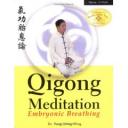bookrev: Embryonic Breathing (Qigong Meditation) by Dr. Yang, Jwing-Ming
 Qi (or chi) is viewed with skepticism by some, as reality by others or as mysticism. This series of books (starting with Embryonic Breathing and continuing with Small Circulation) presents data and perspectives from both translated historical Chinese documents and scientific background perfect for personal research. It also provides an instructional approach on how to practice this stomach based breathing as part of your martial arts or meditation practice.
Qi (or chi) is viewed with skepticism by some, as reality by others or as mysticism. This series of books (starting with Embryonic Breathing and continuing with Small Circulation) presents data and perspectives from both translated historical Chinese documents and scientific background perfect for personal research. It also provides an instructional approach on how to practice this stomach based breathing as part of your martial arts or meditation practice.
Dr. Yang is not only a highly trained martial artist, but also has a PhD in Mechanical Engineering from Purdue, spending some time working at Texas Instruments. His writing relies on both parts of his education: he gives historical descriptions of different aspects of his topic, and then uses science and technology to give modern theories. He always cautions his readers to research, meditate and make up their own minds.
As an example, this is the only martial arts book I have read(other than other titles by Dr. Yang) that has an electronics schematic drawing as a way to show how the human bioelectric circuit is similar to an electric circuit (pg. 117).
I have attended two of Dr. Yang’s qigong seminars, and I find his teaching method in person and in writing similar: a logical, “here’s what I think, what do you think” approach, backed up with quotes from classic Chinese texts.
The first section is introductory theory on Qigong, giving a good overview of basic meridians, vessels and channels, the four refinements, the five regulations and touches on advanced topics such as Small Circulation, Grand Circulation, and Marrow Washing. All of Dr. Yang’s books that I have read start in a similar fashion, with excellent background sections that can be referred to over and over.
The second chapter provides the theory of Embryonic Breathing. Embryonic Breathing is a straightforward concept, taught in most martial arts classes as “breathe with your stomach, not with your chest”, called embryonic because it is the breathing you can observe a baby in a womb employing as it’s stomach expands and contracts. Dr. Yang goes into greater detail in sections titled “Human Qigong Science” and “Theoretical Foundations of Embryonic Breathing”, discussion the three Dan Tiens, combining human anatomy, bioelectricity and Chinese qigong concepts into understandable points.
In Qigong practice, it is commonly known that in order to build up the Qi to a higher level in the Lower Dan Tien, you must move your abdominal area (Lower Dan Tien) up and down through abdominal breathing. This kind of up and down abdominal exercise is called “Qi Huo” and means “start the fire”. It is also called “back to childhood breathing” (Fan Tong Hu Xi).
The chapter finishes with a section on motivations for meditation.
The third and fourth chapters are original Chinese document translations supporting the theories and a summary of those translations. Each translated section is shown in Chinese, with Dr. Yang’s translation and several paragraphs of interpretation (and sometimes alternative translation).
The fifth and final chapter is a practical approach to a personal practice employing embryonic breathing. It goes step-by-step through preparation, practice and recovery, listing suggested positions, do’s and dont’s’, and illustrated movements.
This is a very accessible, easy to study at any chapter text, recommended for any martial artist.


Thank you for the in-depth review on Qigong Meditation Embryonic Breathing by Dr. Yang, Jwing-Ming. You summed it up well with your last sentence, “This is a very accessible, easy to study at any chapter text, recommended for any martial artist.”
Again, thanks!